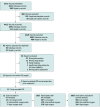Initial Oxygen Concentration for the Resuscitation of Infants Born at Less Than 32 Weeks' Gestation: A Systematic Review and Individual Participant Data Network Meta-Analysis
- PMID: 38913382
- PMCID: PMC11197034
- DOI: 10.1001/jamapediatrics.2024.1848
Initial Oxygen Concentration for the Resuscitation of Infants Born at Less Than 32 Weeks' Gestation: A Systematic Review and Individual Participant Data Network Meta-Analysis
Abstract
Importance: Resuscitation with lower fractional inspired oxygen (FiO2) reduces mortality in term and near-term infants but the impact of this practice on very preterm infants is unclear.
Objective: To evaluate the relative effectiveness of initial FiO2 on reducing mortality, severe morbidities, and oxygen saturations (SpO2) in preterm infants born at less than 32 weeks' gestation using network meta-analysis (NMA) of individual participant data (IPD).
Data sources: MEDLINE, Embase, CENTRAL, CINAHL, ClinicalTrials.gov, and WHO ICTRP from 1980 to October 10, 2023.
Study selection: Eligible studies were randomized clinical trials enrolling infants born at less than 32 weeks' gestation comparing at least 2 initial oxygen concentrations for delivery room resuscitation, defined as either low (≤0.3), intermediate (0.5-0.65), or high (≥0.90) FiO2.
Data extraction and synthesis: Investigators from eligible studies were invited to provide IPD. Data were processed and checked for quality and integrity. One-stage contrast-based bayesian IPD-NMA was performed with noninformative priors and random effects and adjusted for key covariates.
Main outcomes and measures: The primary outcome was all-cause mortality at hospital discharge. Secondary outcomes were morbidities of prematurity and SpO2 at 5 minutes.
Results: IPD were provided for 1055 infants from 12 of the 13 eligible studies (2005-2019). Resuscitation with high (≥0.90) initial FiO2 was associated with significantly reduced mortality compared to low (≤0.3) (odds ratio [OR], 0.45; 95% credible interval [CrI], 0.23-0.86; low certainty) and intermediate (0.5-0.65) FiO2 (OR, 0.34; 95% CrI, 0.11-0.99; very low certainty). High initial FiO2 had a 97% probability of ranking first to reduce mortality. The effects on other morbidities were inconclusive.
Conclusions and relevance: High initial FiO2 (≥0.90) may be associated with reduced mortality in preterm infants born at less than 32 weeks' gestation compared to low initial FiO2 (low certainty). High initial FiO2 is possibly associated with reduced mortality compared to intermediate initial FiO2 (very low certainty) but more evidence is required.
Conflict of interest statement
Figures



Comment in
References
Publication types
MeSH terms
Substances
LinkOut - more resources
Full Text Sources
Medical

